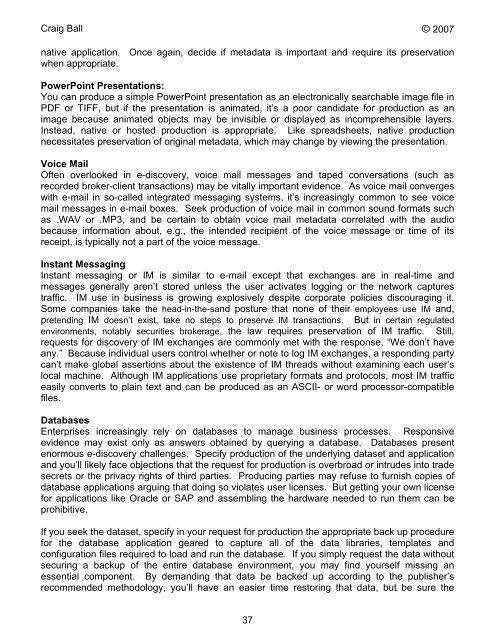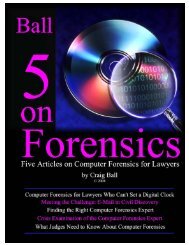Six Articles on Electronic - Craig Ball
Six Articles on Electronic - Craig Ball
Six Articles on Electronic - Craig Ball
You also want an ePaper? Increase the reach of your titles
YUMPU automatically turns print PDFs into web optimized ePapers that Google loves.
<strong>Craig</strong> <strong>Ball</strong> © 2007<br />
native applicati<strong>on</strong>. Once again, decide if metadata is important and require its preservati<strong>on</strong><br />
when appropriate.<br />
PowerPoint Presentati<strong>on</strong>s:<br />
You can produce a simple PowerPoint presentati<strong>on</strong> as an electr<strong>on</strong>ically searchable image file in<br />
PDF or TIFF, but if the presentati<strong>on</strong> is animated, it’s a poor candidate for producti<strong>on</strong> as an<br />
image because animated objects may be invisible or displayed as incomprehensible layers.<br />
Instead, native or hosted producti<strong>on</strong> is appropriate. Like spreadsheets, native producti<strong>on</strong><br />
necessitates preservati<strong>on</strong> of original metadata, which may change by viewing the presentati<strong>on</strong>.<br />
Voice Mail<br />
Often overlooked in e-discovery, voice mail messages and taped c<strong>on</strong>versati<strong>on</strong>s (such as<br />
recorded broker-client transacti<strong>on</strong>s) may be vitally important evidence. As voice mail c<strong>on</strong>verges<br />
with e-mail in so-called integrated messaging systems, it’s increasingly comm<strong>on</strong> to see voice<br />
mail messages in e-mail boxes. Seek producti<strong>on</strong> of voice mail in comm<strong>on</strong> sound formats such<br />
as .WAV or .MP3, and be certain to obtain voice mail metadata correlated with the audio<br />
because informati<strong>on</strong> about, e.g., the intended recipient of the voice message or time of its<br />
receipt, is typically not a part of the voice message.<br />
Instant Messaging<br />
Instant messaging or IM is similar to e-mail except that exchanges are in real-time and<br />
messages generally aren’t stored unless the user activates logging or the network captures<br />
traffic. IM use in business is growing explosively despite corporate policies discouraging it.<br />
Some companies take the head-in-the-sand posture that n<strong>on</strong>e of their employees use IM and,<br />
pretending IM doesn’t exist, take no steps to preserve IM transacti<strong>on</strong>s. But in certain regulated<br />
envir<strong>on</strong>ments, notably securities brokerage, the law requires preservati<strong>on</strong> of IM traffic. Still,<br />
requests for discovery of IM exchanges are comm<strong>on</strong>ly met with the resp<strong>on</strong>se, “We d<strong>on</strong>’t have<br />
any.” Because individual users c<strong>on</strong>trol whether or note to log IM exchanges, a resp<strong>on</strong>ding party<br />
can’t make global asserti<strong>on</strong>s about the existence of IM threads without examining each user’s<br />
local machine. Although IM applicati<strong>on</strong>s use proprietary formats and protocols, most IM traffic<br />
easily c<strong>on</strong>verts to plain text and can be produced as an ASCII- or word processor-compatible<br />
files.<br />
Databases<br />
Enterprises increasingly rely <strong>on</strong> databases to manage business processes. Resp<strong>on</strong>sive<br />
evidence may exist <strong>on</strong>ly as answers obtained by querying a database. Databases present<br />
enormous e-discovery challenges. Specify producti<strong>on</strong> of the underlying dataset and applicati<strong>on</strong><br />
and you’ll likely face objecti<strong>on</strong>s that the request for producti<strong>on</strong> is overbroad or intrudes into trade<br />
secrets or the privacy rights of third parties. Producing parties may refuse to furnish copies of<br />
database applicati<strong>on</strong>s arguing that doing so violates user licenses. But getting your own license<br />
for applicati<strong>on</strong>s like Oracle or SAP and assembling the hardware needed to run them can be<br />
prohibitive.<br />
If you seek the dataset, specify in your request for producti<strong>on</strong> the appropriate back up procedure<br />
for the database applicati<strong>on</strong> geared to capture all of the data libraries, templates and<br />
c<strong>on</strong>figurati<strong>on</strong> files required to load and run the database. If you simply request the data without<br />
securing a backup of the entire database envir<strong>on</strong>ment, you may find yourself missing an<br />
essential comp<strong>on</strong>ent. By demanding that data be backed up according to the publisher’s<br />
recommended methodology, you’ll have an easier time restoring that data, but be sure the<br />
37













